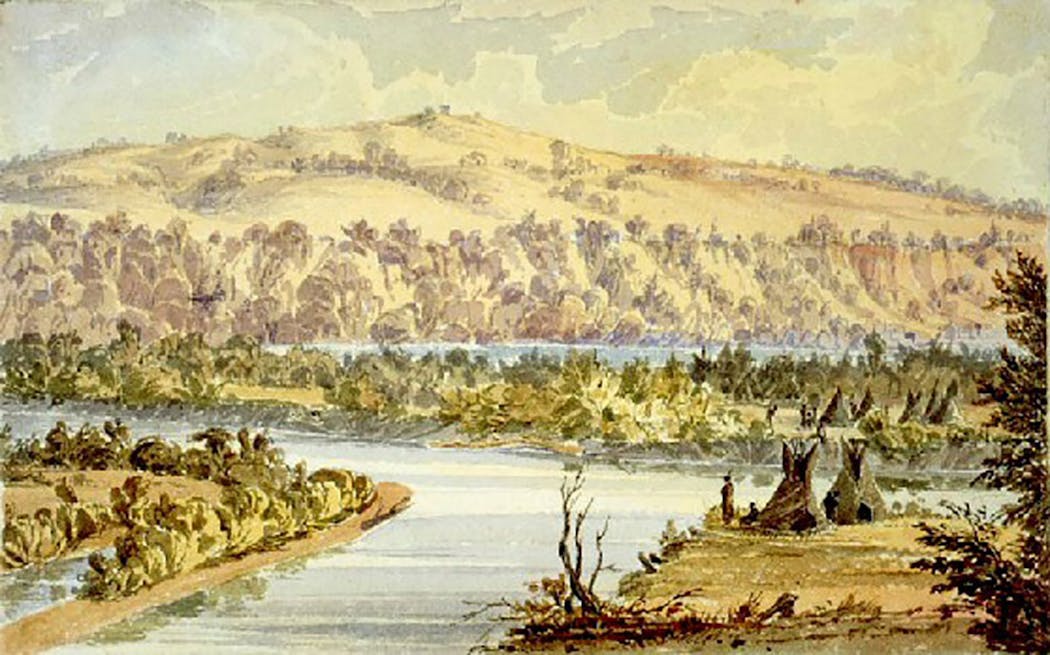What's the story behind Pilot Knob Road and other strange street names in the south metro?
Listen and subscribe to our podcast: Via Apple Podcasts | Spotify | Stitcher
American street names are often simple and straightforward — many are named after either numbers or trees, and Main Streets were once ubiquitous. But observant drivers in the suburbs of Mendota Heights, Eagan and Apple Valley may find themselves cruising down major roads with peculiar names like Pilot Knob, Yankee Doodle and Johnny Cake Ridge.
An anonymous reader found these names intriguing enough to contact Curious Minnesota, our community driven reporting project fueled by readers' questions, wanting to know the history behind the odd names.
Pilot Knob isn't just the name of a thoroughfare that runs from Mendota Heights to Farmington, it's also an 112-acre historic area listed on the National Register of Historic Places in 2017, said Gail Lewellan, co-chair of the Pilot Knob Preservation Association. That area and road got their name from a portion of a prominent, high hill in Mendota Heights that once had a knob-like formation at its peak.
"Riverboat pilots in the 1800s would know that they're almost to downtown St. Paul, or what was becoming St. Paul, when they got to that location," Lewellan said.
The knobbiest part, however, is gone. It was removed in 1925 by owners of Acacia Park Cemetery, which encompasses the hill that once featured the knob, as part of a landscaping plan.
Lewellan said the area is sacred to Dakota people, who called it Oheyawahi, which means either "a hill much visited" or "a sacred place much visited, the place where people go for burials," depending on the translation.
The area has further significance. Illinois Sen. Stephen Douglas suggested in 1848 that Minnesota's territorial capitol be located at Pilot Knob. Later, the Treaty of 1851 was signed at the site, putting 25 million acres of land under the U.S. government's control. In the winter of 1862-63, the area's Dakota people were forced into an internment camp located across the river, below Fort Snelling. Many died, and some were buried on Pilot Knob.
The other two strange names have their own stories, said Matt Carter, director of the Dakota County Historical Society.
He tracked down newspapers from the '60s and '70s to determine the origins of Johnny Cake Ridge Road, which begins in Eagan and ends in Apple Valley. Before portions were paved, the road was named by a local couple who encountered a street named "Johnny Cake Ridge" elsewhere. Some reports say they saw the name in Ohio. The couple were "ordinary, everyday longtime residents" of Eagan, Carter said. One article identifies them as Ethel Fitzgerald and her late husband, and says the road was named in 1960. Johnny Cakes are somewhat similar to pancakes and date back to the Revolutionary War, he added.
Yankee Doodle Road veers horizontally through Eagan before becoming Argenta Trail in Inver Grove Heights. Its back story: During WWI, people "tried to get rid of as much German as they could," Carter said.
Part of what is now Yankee Doodle was once called "Old Schmidt Road" after a local farmer of German descent. Schmidt was sometimes heckled about his address by patrons at a St. Paul tavern he visited weekly to water his horse and eat a meal, Carter said.
Tired of the teasing, Schmidt came up with the most American-sounding name he could for the street: Yankee Doodle Road. The name stuck, Carter said.
Joanna Foote, the city of Eagan's liaison to the Eagan Historical Society, confirmed the Yankee Doodle story, though she said the German-American resident who wanted to avoid being mocked may have been simply someone who lived on the road, not Schmidt himself, and that the road's previous name was "Schmidt's Road."
It's hard to know when the new name took off, Carter said, since the street was still called Schmidt Road in 1916 and the 1920 census didn't list street addresses.
Today, Carter said, many streets are named by housing developers, with input from the community.
---
If you'd like to submit a Curious Minnesota question, fill out the form below:
Read more Curious Minnesota stories:
Why is Minnesota more liberal than its neighboring states?
Why do tiny cities like Lauderdale, Landfall and Falcon Heights exist?
When you flush a toilet in the Twin Cities, where does everything go?
Why do gas prices vary so much around Minnesota?
Does Minnesota or some other state have the best claim to Paul Bunyan?
St. Paul vs. Minneapolis: Why are the roots of the rivalry?
![Ryan Youngdale stands in front of the beer fridge at Stinson Wine, Beer, and Spirits. ] COURTNEY PEDROZA ¥ courtney.pedroza@startribune.com July 2, 2](https://arc.stimg.co/startribunemedia/FYETJNT4CSHIH3EH5M3DJXT7VY.jpg?w=600&h=600&auto=format%2Ccompress&cs=tinysrgb)



